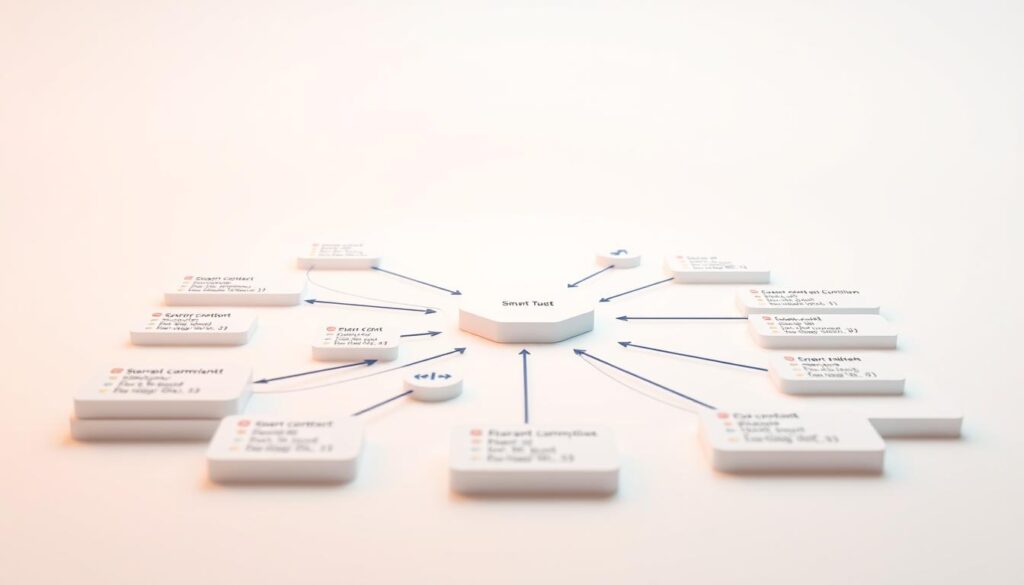Now Reading: Blockchain governance models decentralized autonomous organizations and voting mechanisms
- 01
Blockchain governance models decentralized autonomous organizations and voting mechanisms
Blockchain governance models decentralized autonomous organizations and voting mechanisms

Imagine a world where groups make decisions without CEOs or boards. This vision drives today’s most innovative digital communities, powered by systems that automate rules and share control. These frameworks blend transparent processes with collective input, creating fresh ways to manage projects and resources.
At their core, these systems use self-executing agreements to enforce participation guidelines. Members often hold special access tokens that let them shape policies through voting mechanisms. This approach flips traditional power structures, as explored in our analysis of DAO governance structures.
From creative collectives to investment groups, these models demonstrate how shared ownership can drive innovation. They enable real-time tracking of decisions while maintaining security through advanced verification methods. As these systems evolve, they’re creating blueprints for more equitable organizational participation.
Key Takeaways
- Self-managed groups replace traditional hierarchies with automated rule systems
- Participation tokens enable direct influence over group decisions
- Transparent tracking ensures accountability in resource management
- Multiple industry applications demonstrate practical implementations
- Security features protect against unauthorized changes to core systems
- Legal considerations continue evolving alongside these innovations
Introduction to Blockchain Governance and DAOs
Digital collaboration took a revolutionary turn in 2008 when Satoshi Nakamoto proposed peer-to-peer systems through the Bitcoin whitepaper. This concept evolved into code-based frameworks where rules live in software rather than boardrooms. By 2013, these ideas matured into decentralized autonomous companies (DACs), using digital tokens as membership shares.
Early DACs demonstrated how organizations could operate without physical offices. Members used crypto assets to vote on proposals directly, bypassing traditional management layers. These experiments laid groundwork for today’s self-operating networks that manage assets and decisions through programmed logic.
Modern versions replace corporate hierarchies with automated systems. Participants earn influence through token ownership, creating fluid power structures. Unlike conventional firms, these groups maintain operations through global networks of users rather than centralized leadership teams.
Key innovations include tamper-proof voting records and real-time proposal tracking. These features address historical challenges like transparency gaps in group decision-making. As digital-native entities, they showcase how distributed technologies enable new collaboration models across industries.
What are Blockchain governance models decentralized autonomous organizations?
Modern collectives are rewriting organizational rulebooks through code-driven collaboration. Unlike traditional companies, these user-owned networks operate through shared participation rather than executive mandates. Members collectively steer priorities using tools that enforce fairness through mathematics.

At their core, these systems rely on self-executing agreements called smart contracts. These digital protocols handle everything from fund distribution to policy updates. Developers create initial frameworks, but control shifts to participants holding governance tokens.
Every operational detail remains publicly visible on distributed ledgers. This transparency lets members verify processes before joining or investing. Through decentralized autonomous organizations, groups manage assets without intermediaries by encoding rules into tamper-proof code.
Decision-making power scales with token ownership, creating fluid leadership structures. Proposals pass only when reaching predefined approval thresholds. This approach removes single points of failure while maintaining operational efficiency through automated workflows.
Resource allocation follows clear formulas instead of boardroom negotiations. Budgets update in real-time as members vote on initiatives through secure portals. Such systems demonstrate how technology enables collective stewardship at unprecedented scales.
The Role of Smart Contracts in DAO Operations
Digital collectives achieve operational consistency through self-enforcing protocols. These systems replace paper agreements with mathematical certainty
Defining the Code Behind DAOs
Developers create foundational scripts that dictate how groups manage resources and make choices. These code-based frameworks handle membership rights, proposal thresholds, and reward distribution. Anyone can audit the logic powering decisions through public blockchain explorers.
Core teams establish initial parameters like voting durations and quorum requirements. Once deployed, these scripts operate independently – executing approved actions when predefined conditions meet. This setup eliminates interpretation gaps in rule enforcement.
Automation and Transparency in Voting
Proposal systems powered by smart contracts transform suggestions into executable code. Members cast votes using digital tokens, with results calculated automatically. The table below contrasts traditional decision-making with code-driven processes:
| Process Stage | Traditional Systems | Smart Contract Systems |
|---|---|---|
| Proposal Submission | Email/Physical documents | On-chain transactions |
| Voting Verification | Manual tallying | Automatic cryptographic checks |
| Result Execution | Human-dependent | Instant code triggers |
This automated approach reduces administrative costs while preventing human errors. Real-time tracking lets members confirm each step’s validity through permanent records. Funds move only when collective decisions satisfy programmed criteria.
The Evolution and Digital Nature of DAOs
Online communities in the 1990s unknowingly planted seeds for modern collaboration frameworks. Early open-source software projects demonstrated how strangers could build complex systems through shared goals. As legal scholar Aaron Wright notes: “DAOs connect people through code-based systems focused on shared missions” – a direct evolution of these pioneering efforts.

Origins in the Internet Age
Linux and Wikipedia showed the power of distributed teamwork long before crypto existed. These projects proved three key principles:
- Transparent development builds trust
- Merit-based participation drives quality
- Shared ownership sustains projects
Blockchain technology later provided tools to formalize these concepts. Early DAO creators translated community-driven workflows into enforceable digital rules.
Transition to Digital-First Organizations
Traditional companies require physical offices and legal registrations. DAOs operate through:
- Cloud-based communication platforms
- Automated treasury systems
- Global participant networks
This shift enables 24/7 operations across continents. Members contribute from anywhere using encrypted voting tools and real-time proposal trackers. The digital nature of these systems eliminates geographical barriers that once limited organizational growth.
Exploring Diverse DAO Governance Models
Modern tech-driven groups demonstrate how token-based communities tackle collective challenges through unique frameworks. Two pioneering initiatives reveal contrasting methods for managing resources and decisions at scale.
ConstitutionDAO and Its Unique Approach
In 2021, 17,000 contributors united through a shared mission: acquiring a historic document using pooled crypto assets. This collective raised $47 million in Ether within seven days through transparent wallet tracking. Though outbid at auction, the effort proved how time-bound initiatives could mobilize global participation for cultural preservation.
Ethereum Name Service DAO Insights
The ENS framework balances structure with flexibility through its three-phase decision process:
| Stage | Platform | Purpose |
|---|---|---|
| Discussion | Community Forum | Idea refinement |
| Signaling | Discord Polls | Sentiment analysis |
| Execution | On-Chain Voting | Fund allocation |
Delegates representing token holders help streamline decisions without central authority. This layered approach maintains responsiveness while preventing hasty changes to core systems.
Voting Mechanisms: How DAOs Make Collective Decisions
Digital communities are redefining group decision-making through innovative voting tools. These systems combine social coordination with code-based rules, allowing members to shape outcomes directly. Unlike traditional polls, these methods ensure every voice gets mathematically verified representation.

Balancing Speed and Participation
Most groups use token-based voting where influence matches stake. However, some implement delegate systems to streamline choices. The table below shows common approaches:
| Method | Approval Threshold | Time Frame |
|---|---|---|
| Simple Majority | 50%+1 votes | 3-7 days |
| Supermajority | 66% or 75% | 5-14 days |
| Liquid Delegation | Variable | Continuous |
Friends With Benefits DAO illustrates this evolution. Their process begins with Discord discussions before formalizing proposals. Members then vote using Snapshot – a platform eliminating transaction fees through off-chain signatures.
Low Barriers, High Impact
A 1% quorum requirement accelerates decision-making while maintaining legitimacy. This approach works well for NFT communities managing fast-moving projects. Real-time dashboards track participation rates, helping groups identify engagement gaps.
Three key factors drive successful voting systems:
- Clear proposal formatting standards
- Mobile-friendly voting interfaces
- Transparent result tracking
As these mechanisms mature, they’re creating new standards for digital collaboration. The challenge lies in balancing efficiency with inclusive participation across global networks.
Treasury Management and Funding in Decentralized Organizations
Digital collectives face unique financial challenges when managing shared resources. These groups use token-based systems to pool funds while maintaining transparent accounting. Unlike traditional corporations, every transaction gets recorded on public ledgers for member verification.
Most DAOs start by issuing digital tokens through crowdfunding campaigns. Contributors receive voting rights proportional to their holdings, aligning financial stakes with decision power. Platforms like JuiceboxDAO streamline this process with pre-built tools for:
| Function | Traditional Approach | DAO Solution |
|---|---|---|
| Fundraising | Bank loans | Token sales |
| Budget Approval | Board meetings | On-chain voting |
| Payment Processing | Manual transfers | Smart contract automation |
Security remains critical when handling group treasury assets. Multi-signature wallets require multiple approvals before releasing funds, preventing unilateral actions. Regular audits and real-time dashboards help communities track spending against approved proposals.
Successful systems balance flexibility with accountability. The community decides funding priorities through structured voting mechanisms while automated tools enforce compliance. This approach enables global collaboration without sacrificing financial oversight.
Decentralized and Democratic Decision Making in DAOs
New collaboration frameworks are challenging traditional power structures through token-based systems that distribute authority. These networks replace top-down hierarchies with collective input, letting members shape outcomes proportionally to their participation. Smart contracts automate decisions, removing intermediaries while ensuring rule enforcement matches community consensus.
Every participant gains influence through digital tokens, creating fluid leadership roles. Voting mechanisms blend legal frameworks with behavioral economics, turning abstract concepts into executable code. This approach enables transparent processes where proposals succeed only after meeting predefined approval thresholds.
The system’s strength lies in balancing structure with flexibility. Routine updates might require simple majority votes, while core protocol changes demand supermajority support. Members track decisions in real-time through immutable ledgers, creating accountability without centralized oversight.
These models demonstrate how technology can scale democratic participation globally. By encoding rules into self-executing agreements, groups maintain operational integrity while adapting to member needs. The result? Governance that evolves organically through distributed input rather than rigid hierarchies.














